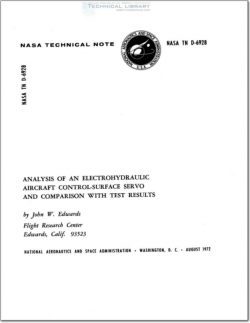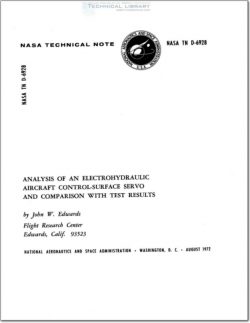NASA-TN-D-6928

- Version
- 134 Downloads
- 2.55 MB File Size
- 1 File Count
- June 16, 2016 Create Date
- June 16, 2016 Last Updated
Analysis of an Electrohydraulic Aircraft Control Surface Servo and Comparison with Test Results

During the past decade, the use of electrohydraulic servomechanisms in aircraft
flight—control systems has become commonplace. They are used to provide power boost,
stability augmentation control inputs, or primary control of the vehicle. Because of
weight and space limitations, there is always a design trade-off in the installation of
such a system concerning the structural stiffness of its components. In a well—designed
electrohydraulic control-surface system, a well—behaved system with a first—order-
lag dynamic response may be achieved. The system time constant is determined by
the position feedback gain.
In some instances this desirable response is not achieved because excessive struc—
tural compliance causes the system to be highly resonant. This was true of a rudder
control servo installed in the NASA general purpose airborne simulator (GPAS).
Attempts to damp such systems have led to the use of dynamic pressure feedback (DPF),
in which high-pas sed pressure feedback provides the necessary damping.
The literature on electrohydraulic systems is extensive (refs. 1 to 8, for example);
however, there does not seem to be any readily available analysis of this type of sys—
tem, which is often encountered in aircraft control—surface systems. The purpose of
this report is to analyze a lumped, two—mass model of an aircraft control—surface
servo and to illustrate the use of DPF. The effect of hinge-moment loading of the con-
trol surface is included. The model is linearized, transfer functions of the pertinent
variables are derived, and the effectiveness of DPF in damping the load resonance is
investigated. The nonlinear and linear responses of the model are compared with
experimental measurements of the highly resonant rudder control servo installed in
the GPAS.
| File | Action |
|---|---|
| NASA-TN-D-6928 Analysis of an Electrohydraulic Aircraft Control Surface Servo and Comparison with Test Results.pdf | Download |
Comment On This Post